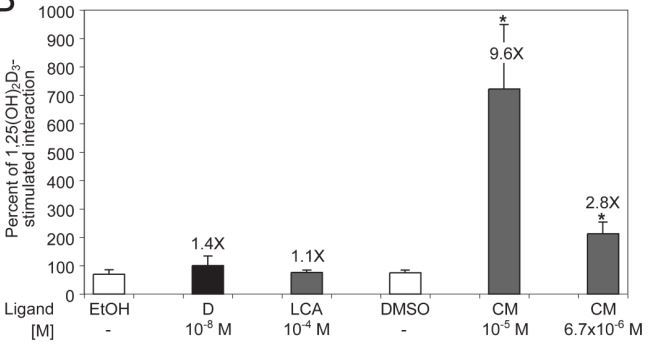Curcumin may increase Vitamin D in tissues (activates Vitamin D Receptor)
Curcumin: a novel nutritionally derived ligand of the vitamin D receptor with implications for colon cancer chemoprevention
J Nutr Biochem. 2010 Dec;21(12):1153-61. doi: 10.1016/j.jnutbio.2009.09.012.
Bartik L1, Whitfield GK, Kaczmarska M, Lowmiller CL, Moffet EW, Furmick JK, Hernandez Z, Haussler CA, Haussler MR, Jurutka PW.
1 Department of Biochemistry and Molecular Biophysics, College of Medicine, The University of Arizona, Tucson, AZ 85724, USA.
📄 Download the PDF from Vitamin D Life

Clipped from PDF: 8 grams of Curcumin
- “Activation of VDR by CM required a much higher concentration (10−6 to 10−5 M) than the endocrine 1,25D ligand (10−8M), suggesting that a relatively low-affinity ligand may not achieve physiologic levels. However, up to 8 g of CM can be safely administered orally to human subjects on a daily basis, potentially leading to plasma concentrations greater than 10−6M [33]”
The nuclear vitamin D receptor (VDR) mediates the actions of 1,25-dihydroxyvitamin D(3) (1,25D) to regulate gene transcription. Recently, the secondary bile acid, lithocholate (LCA), was recognized as a novel VDR ligand. Using reporter gene and mammalian two-hybrid systems, immunoblotting, competitive ligand displacement and quantitative real-time PCR, we identified curcumin (CM), a turmeric-derived bioactive polyphenol, as a likely additional novel ligand for VDR. CM (10(-5) M) activated transcription of a luciferase plasmid containing the distal vitamin D responsive element (VDRE) from the human CYP3A4 gene at levels comparable to 1,25D (10(-8) M) in transfected human colon cancer cells (Caco-2). While CM also activated transcription via a retinoid X receptor (RXR) responsive element, activation of the glucocorticoid receptor (GR) by CM was negligible. Competition binding assays with radiolabeled 1,25D confirmed that CM binds directly to VDR. In mammalian two-hybrid assays employing transfected Caco-2 cells, CM (10(-5) M) increased the ability of VDR to recruit its heterodimeric partner, RXR, and steroid receptor coactivator-1 (SRC-1). Real-time PCR studies revealed that CM-bound VDR can activate VDR target genes CYP3A4, CYP24, p21 and TRPV6 in Caco-2 cells. Numerous studies have shown chemoprotection by CM against intestinal cancers via a variety of mechanisms. Small intestine and colon are important VDR-expressing tissues where 1,25D has known anticancer properties that may, in part, be elicited by activation of CYP-mediated xenobiotic detoxification and/or up-regulation of the tumor suppressor p21. Our results suggest the novel hypothesis that nutritionally-derived CM facilitates chemoprevention via direct binding to, and activation of, VDR.
